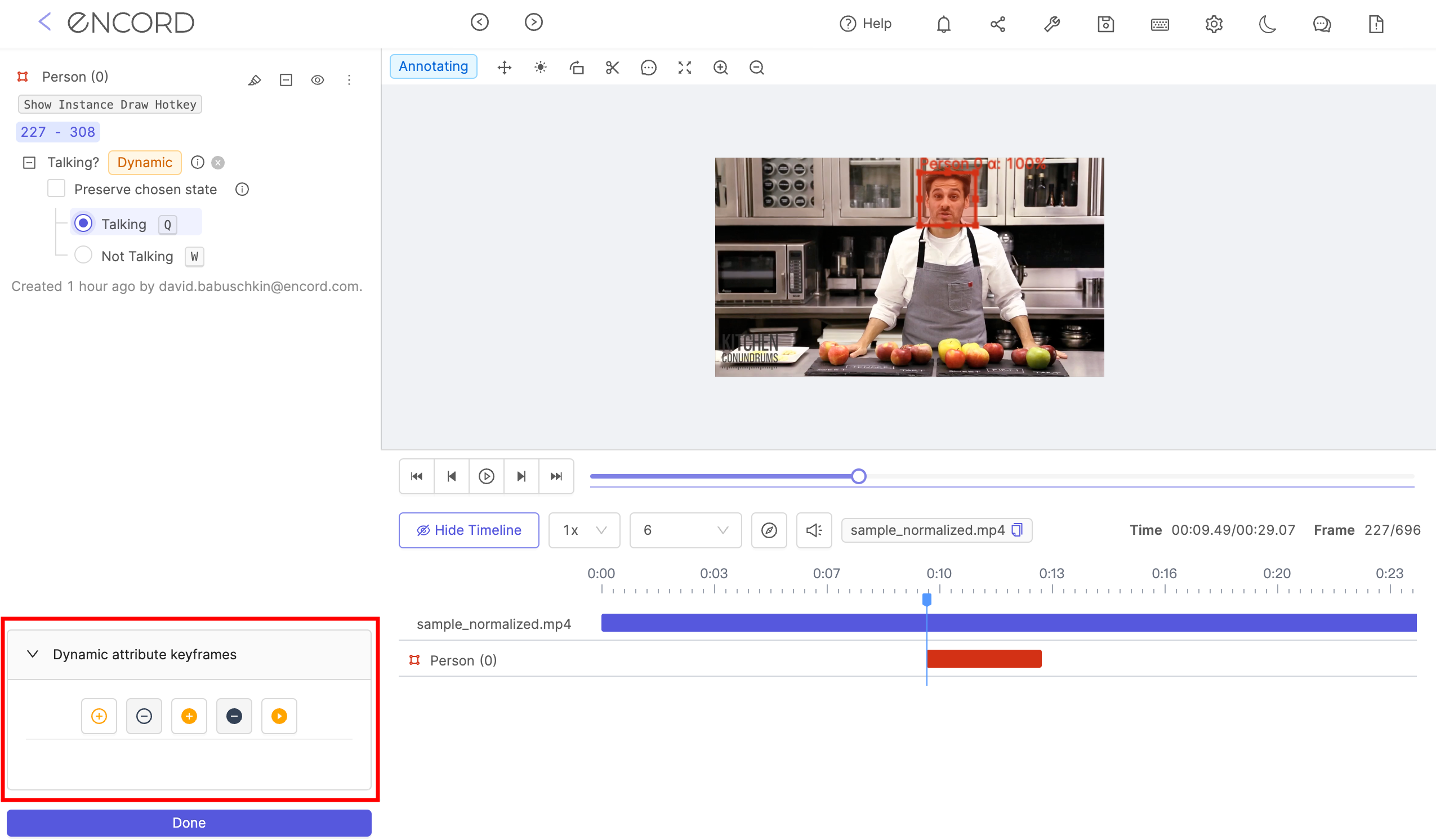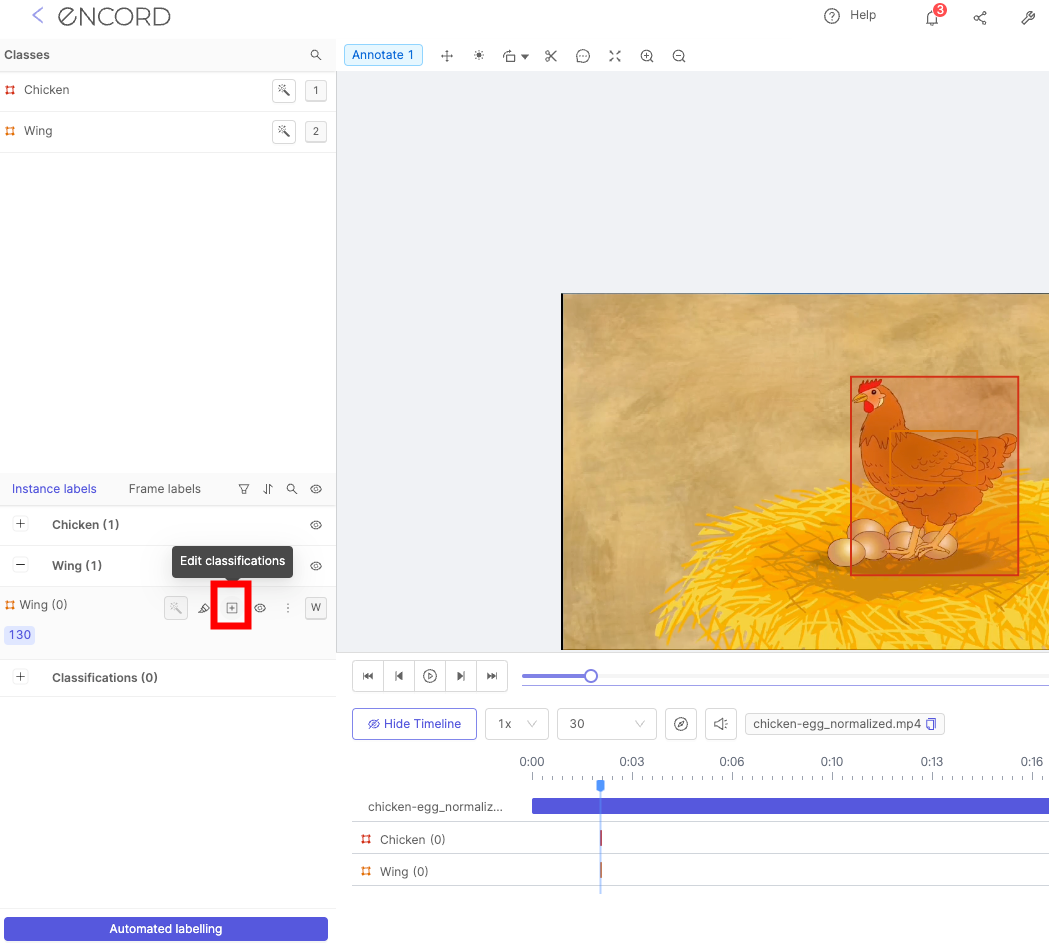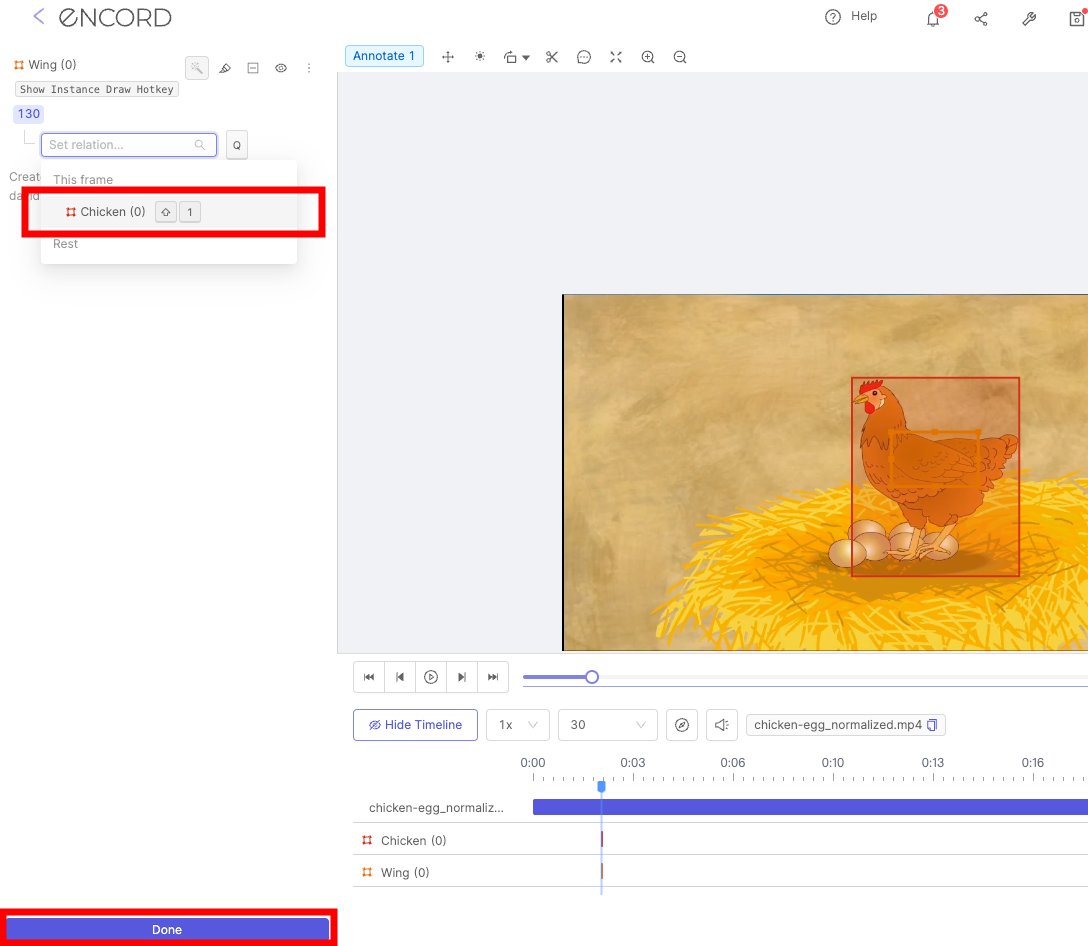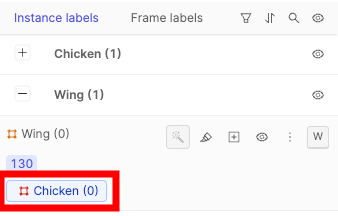- Label using any annotation type.
- Render videos and image sequences of any length.
- Track and interpolate objects between frames.
- Create frame-level and object event classifications.
- Reduce manual annotations with automation features.
Navigation
Play/pause the video by clicking the play/pause button or by pressing Space. Skip through frames in the video with the Left and Right arrow keys or the forward and backward buttons. The number of frames skipped is determined by the specified Frameskip interval. Frameskip intervals can be set using the predefined values or customized by entering a value in the New input and clicking the + icon. Control video playback speeds with the playback speed drop-down. 1x is the set playback speed in the below example.


Annotation Types
Objects are annotated using bounding boxes, polygons, polylines, keypoints or primitives. Frames are annotated using classifications. Instantiating objects or classifications in the video editor generates a UUID that uniquely identifies that instance across a range of frames (i.e., in the temporal dimension). The identifier is sometimes called a “track,” with numerical IDs supplementing UUIDs for objects for visual aid. Supported annotation types & corresponding features are listed in the table below. You can read more about the listed automation features here.| Annotation type | Dynamic attribute | Automated tracking | Interpolation | Import predictions | Model training & inference |
|---|---|---|---|---|---|
| Bounding box | ✅ | ✅ | ✅ | ✅ | ✅ |
| Rotatable bounding box | ✅ | ✅ | ✅ | ✅ | Coming soon |
| Polygon | ✅ | Coming soon | ✅ | ✅ | ✅ |
| Polyline | ✅ | ✅ | ✅ | ✅ | Coming Soon |
| Keypoint | ✅ | ✅ | ✅ | ✅ | ✅ |
| Bitmask | ✅ | N/A | ✅ | ✅ | N/A |
| Object primitive | N/A | ✅ | N/A | ✅ | N/A |
| Frame classification | N/A | N/A | N/A | ✅ | ✅ |
Bounding box
Creating a bounding box requires an Ontology with a bounding box annotation type. Instantiate a new bounding box instance by clicking on the specified class in the ‘Classes’ menu, or by using the specified hotkey (for example: 1, 2, 3).

- Highlight an object by clicking on it in the editor canvas or by clicking on the Plus icon or start/end frame in the range overview for the specified bounding box
- Assign a classifications by clicking on the relevant buttons or using the set hotkeys (for example q, u).

Tracking
Run automated object tracking by highlighting an object and clicking shift + t on your keyboard.

Interpolation
Interpolation is run via the ‘Automated labeling’ drawer. Click the Automated labeling button to open the drawer. Select Interpolation from the drop-down menu, select the desired objects to interpolate, set the interpolation range (i.e., the range of frames) and click the Run interpolation button. Please note that you need a minimum two labels of an instance to run interpolation.
Rotating box
Traditional bounding boxes are great for annotating objects that appear in horizontal or vertical orientation, however, their accuracy may be limited when it comes to annotating objects at an angle. In such cases, use rotatable boxes to produce more accurate annotations. Creating a rotatable bounding box requires an Ontology with a rotatable box annotation type. Rotatable box labels can be assigned with static classifications should they be defined in your ontology. Instantiate a new rotatable box label by clicking on the specified class in the ‘Classes’ menu or using the specified hotkey. Resize rotatable boxes like normal bounding boxes, and then grab the rotation handle to adjust the position until you’re satisfied with the annotation’s accuracy, as below.
Polygon
Creating a polygon requires an Ontology with a polygon annotation type. Enable or disable free-hand drawing mode by pressing d on your keyboard. Polygon coarseness for polygons drawn free-hand is set in the ‘Settings’ drawer in the Drawing settings drop-down. Instantiate a new polygon instance by clicking on the specified class in the ‘Classes’ menu or using the specified hotkey (e.g., 1, 2, 3). A polygon can be closed by double-clicking anywhere on the canvas. Doing so will “snap” creating an edge between the last vertex to the first vertex drawn.
- Highlight an object by clicking on it in the editor canvas or by clicking on the Plus icon or start/end frame in the range overview for the specified polygon.
- Assign classifications by clicking on the relevant buttons or using the set hotkeys (for example q, u).
Interpolation
Run polygon interpolation following the instructions for bounding box, which you can find here. Unlike other linear interpolation methods, Encord’s polygon interpolation algorithm does not require a matching number of vertices between polygon objects in set keyframes. Our algorithm also allows you to draw polygons in arbitrary directions (e.g., clockwise, counterclockwise, and otherwise).Editing polygons with the brush tool
You can edit existing polygons with the brush tool. This allows you to create complex shapes in a much faster way than going vertex by vertex. To use the brush tool, select an existing polygon and then click on the brush tool button. This will show the brush tool settings panel where you can choose brush or eraser and change its size. Once you are done editing, click the “x” to go back to the label editor. Use the scissors tool if you’d like to remove vertices.
Polyline
Creating a polyline requires an Ontology with a polyline annotation type. Enable or disable free-hand drawing mode by pressing d on your keyboard. Polyline coarseness for polylines drawn free-hand is set in the ‘Settings’ drawer in the Drawing settings drop-down. Instantiate a new polyline instance by clicking on the specified class in the ‘Classes’ menu or using the specified hotkey (e.g., 1, 2, 3). Polylines can be copy/pasted between frames using cmd (MacOS)/ctrl (Windows) + C to copy the object to the clipboard and cmd/ctrl + V to paste it at the location of the mouse cursor on the desired frame. Complete a polyline by double-clicking anywhere on the canvas.
- Highlight an object by clicking on it in the editor canvas or by clicking on the Plus icon or start/end frame in the range overview for the specified polyline.
- Assign a classification by clicking on the relevant buttons or using the set hotkeys (for example q, u).
Keypoint
Creating a keypoint requires an Ontology with a keypoint annotation type. Instantiate a new keypoint instance by clicking on the specified class in the ‘Classes’ menu or using the specified hotkey (e.g., 1, 2, 3).
- Highlight an object by clicking on it in the editor canvas or by clicking on the Plus icon or start/end frame in the range overview for the specified keypoint.
- Assign classifications by clicking on the relevant buttons or using the set hotkeys (for example q, u).
Automated tracking
Run automated keypoint tracking following the instructions for bounding box, which you can find here.Interpolation
Run keypoint interpolation following the instructions for bounding box, which you can find here.Primitives
Creating a primitive (f.k.a. skeleton templates) requires an Ontology with a primitive annotation type. Use primitives to templatize shapes (e.g., 3D cuboids, pose estimation skeletons ) commonly used by your annotation team. Instantiate a new primitive instance by clicking on the specified class in the ‘Classes’ menu or using the specified hotkey (e.g., 1, 2, 3). Instantiate existing primitive instances (i.e., primitives that should keep the same identifier in preceding or succeeding frames) by clicking on the Highlight icon for the specified object or using the assigned hotkey (e.g., q, w, e). See the bounding box documentation for visual instructions on how to instantiate existing primitives. Primitives can be copy/pasted between frames using cmd (MacOS)/ctrl (Windows) + C to copy the object to the clipboard and cmd/ctrl + V to paste it at the location of the mouse cursor on the desired frame. Primitives allow you to define properties of edges defined in your template as visible, occluded, or invisible. Toggle the edge property settings for a primitive by highlighting the primitive and clicking the Show controls button.
- Highlight an object by clicking on it in the editor canvas or by clicking on the Plus icon or start/end frame in the range overview for the specified primitive.
- Assign classifications by clicking on the relevant buttons or using the set hotkeys (for example q, u) See the bounding box documentation for visual instructions on how to assign classifications.
Automated tracking
Run SAM 2 tracking following the instructions for bounding box, which you can find here.Interpolation
Run primitive interpolation following the instructions for bounding box, which you can find here.Segmentation masks / Bitmasks
When creating a bitmask, the process continues until you press the ENTER or ESC key. This allows you to easily create complex bitmask labels without interruption.

Creating a bitmask segmentation requires an Ontology with the Bitmask annotation type.
Brush tool
When selecting the bitmask annotation type, the brush tool is selected by default. Adjust the size of the bitmask brush tool using the slider in the bitmask popup. When your label is ready, click Apply label, or press Enter.Panoptic mode

- None: Overlapping bitmasks are allowed. The bitmask overlaps with existing bitmasks.
- Exclude: Areas already covered by a bitmask are excluded from the bitmask.
- Overwrite: Areas already covered by a bitmask are overwritten by the new bitmask.
Thresholding
The Thresholding tool enables you to set a threshold that determines the parts of the image or frame that is labeled by the Bitmask. Consequently, only the parts of the image falling within th predefined range are labeled upon selection with the Thresholding tool, ensuring precise and targeted labeling.
- Intensity: Only pixels within the set intensity value range are labeled.
- RGB: Only pixels within the set red, green, and blue range are labeled. The range for each color can be set separately.
- HSV: Only pixels within the set hue, saturation, and value range are labeled.
Eraser
The Eraser tool allows you to erase parts, or the entirety of your Bitmask selection if the Apply label button has not been clicked yet. To select the threshold brush, click the eraser icon, or press h on your keyboard while the popup is open.Combine bitmasks on an image/frame
Combining bitmasks on an image or frame allows you to label objects that are split/separated in the image/video frame.When creating a bitmask, the process continues until you press the ENTER or ESC key. This allows you to easily create complex bitmask labels without interruption.
- Hold SHIFT.
- Click the bitmasks you want to combine in the Label Editor workspace.
- Right-click (on Mac press Cmd). A menu appears.
- Select Combine bitmasks into. The bitmasks are now a single bitmask.
Bitmask overlap management
It is possible to prevent a Bitmask label from being overlapped by subsequent Bitmasks after the label is created. Use the toggle in the Labels section of the Label Editor to set the overlap behavior.
- Can be drawn over - If the Bitmask is drawn over, any part of the image beneath the existing Bitmask that falls within the specified threshold range is included in the next label.
- Cannot be drawn over - No part of the image covered by this Bitmask is included in any other Bitmask labels.
- Must be drawn over - If the Bitmask is drawn over, any part of the Bitmask label is included in the new Bitmask, regardless of threshold values set.
The Must be drawn over setting for Bitmask overlap is only available to select customers. Contact [email protected] for more information.
Updating bitmask labels
To update a bitmask label:- Click the bitmask label you want to edit.
- Select either the brush, threshold brush, or eraser tool and make your changes.
- Press Enter or click the Update label button in the bitmask popup.
Moving bitmasks
Bitmask labels can be moved to another location after being created.- Click the bitmask label you want to move.
- Click and drag the bitmask to the desired location.
- Release the bitmask to confirm the new location.

Frame classification
Creating frame classification(s) requires an Ontology with a classification annotation type. Frame-level classifications consider the frame as a whole, not the objects’ localization. Instantiate a frame-level classification instance by clicking on the specified class in the ‘Classes’ menu or using the specified hotkey (for example: 1, 2, 3). Set the desired start and end frame by clicking the Set start to current and Set end to current buttons or using the set hotkeys c and v, respectively. Click the This frame button or the x hotkey to set the slider to only the current frame (e.g., frame 100). Add additional ranges by clicking the Add range button or pressing the n hotkey to add a frame range (e.g., if a car enters and leaves the frame throughout a video). Click the Save button or the m hotkey to save the instance. Use the This frame & save button or the z hotkey to classify and save the results for a single frame quickly.
Dynamic attributes
Encord supports dynamic attributes for all object annotation types (i.e., bounding box, polygon, polyline, keypoint, and primitives). Highlight the desired object to assign dynamic attributes. Dynamic attributes are recognized by the Dynamic tag next to the given feature in the ontology. Dynamic attributes are only applied in the frames specifically indicated but can be edited in ranges if they span multiple frames.
Using dynamic attributes
The video tutorial goes through the basics of working with Dynamic Attributes in the Label Editor.Bulk apply dynamic attributes
You can efficiently apply dynamic attributes in bulk to save time and effort. This is accomplished by identifying frames where the attribute changes value as “keyframes,” and then applying attribute values between these keyframes.
- Apply object labels to all relevant frames.
- Add the dynamic attribute to the label in the first frame that the object appears in.
- Navigate to the point of the video or image sequence where the dynamic attribute changes value, and apply the attribute to the object here.
- Use the + icon, or the keyboard shortcut Shift + L to set keyframes on frames where the attribute changes value.
- Use the Play icon, or the keyboard shortcut Shift + P to apply attribute values to all frames following a keyframe, matching the value set in the keyframe.
All frames in between keyframes have to be labeled for attribute propagation to work.
- Use the
 icon, or the keyboard shortcut Shift + A to add a keypoint to a frame.
icon, or the keyboard shortcut Shift + A to add a keypoint to a frame. - Use the
 icon, or the keyboard shortcut Shift + S to remove a keypoint from a frame.
icon, or the keyboard shortcut Shift + S to remove a keypoint from a frame.
Frame labels tab
The Frame labels tab will show all instances with a label in the current frame, and will be empty when there are no labels in a given frame.Editor Timeline
The Editor timeline is a visualization of the times and durations at which objects and instances appear within a video. Every object added by an annotator will automatically appear on the timeline at the point in time when it is added. The colors of an object on the timeline match those used to label the objects in the video.
- The ‘lake’ object was added at the start of the video (0:00), and is present in all frames in the first 7 seconds of the video.
- There are 3 separate instances of a ‘boat’ object - the times in the video at which they appear, and the duration of the annotations.


The editor timeline is available in both the Annotation and Review states for videos.
Zoom and Sort By

Selecting Objects and Instances
One or more objects and instances can be selected using the timeline. Simply click an object or instance on the timeline to select it. To select multiple objects or instances, click while holding down the Shift key. Alternatively select an object or instance by right-clicking and choosing Select.
Moving Objects and Instances
Once objects and instances have been selected they can be moved to the top or the bottom of the timeline to suit your needs.- Select the instances and objects you want to move.
- Right-click your selection.
- Hover on Move when moving a single object or instance, and Move all when moving multiple objects or instances.
- Select To top or To bottom depending on whether you want to move the object(s) and instance(s) to the top or the bottom of the timeline.
Merging Instances on the Timeline
Multiple instances of the same object can be merged into a single instance of your choice, provided they don’t appear on the same frame.- Select the instances you want to merge.
Hold SHIFT to select multiple instances.
- Right-click your selection.
- Hover on Merge into.
- Select the instance you want to merge your selection into.

Linking Object Instances
Object instances are linked using Relation attributes, which are set up in the Ontology. See our documentation on Relation attributes to learn more.
- Create both instance labels. In this example a chicken and its wing have been labeled using bounding boxes.
- Click the Edit classifications button for the object with the Relation attribute. In the example this object is the wing, as seen below.

- Click the Set relation… bar and select the instance you want to link the selected instance to. In our example the chicken and the wing appear on the same frame, and therefore appear under the This frame heading. Instances in different frames will appear under the heading Rest.

- Click Done. The instances are now linked. This is shown in the Instance labels section with the name of the linked instance being displayed.

Automation
Supported annotation types and available automation features are listed in the table below.| Annotation type | Dynamic attribute | SAM 2 TRacking | Interpolation | Import predictions |
|---|---|---|---|---|
| Bounding box | ✅ | ✅ | ✅ | ✅ |
| Rotatable bounding box | ✅ | ✅ | ✅ | ✅ |
| Polygon | ✅ | ✅ | ✅ | ✅ |
| Polyline | ✅ | ❌ | ✅ | ✅ |
| Keypoint | ✅ | ❌ | ✅ | ✅ |
| Bitmask | ✅ | ✅ | ✅ | ✅ |
| Object primitive | N/A | ❌ | N/A | ✅ |
| Frame classification | N/A | N/A | N/A | ✅ |
Interpolation
Encord’s interpolation feature uses a proprietary linear interpolation algorithm that runs without using a representational model or matching pixel information in neighboring frames. Our interpolation algorithm has been built with pragmatic usage in mind. For example, unlike other linear interpolation methods, Encord’s interpolation algorithm does not require a matching number of vertices between objects in set keyframes. Our algorithm also allows you to draw object vertices in arbitrary directions (e.g., clockwise, counterclockwise, and otherwise).

